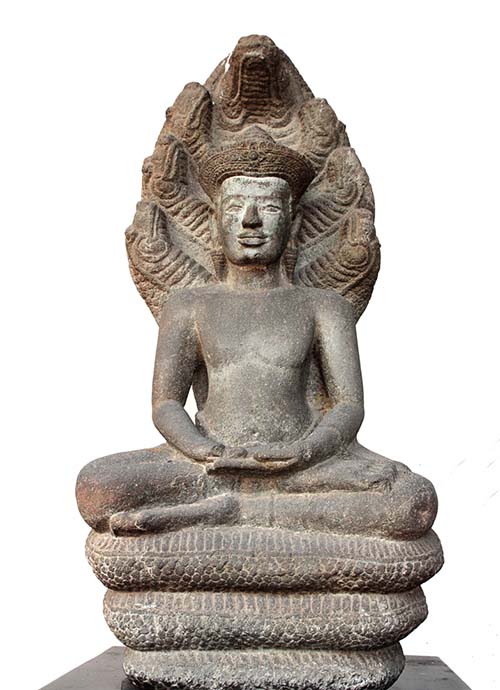
Meditation Mudra
Meaning & origin of the meditation mudra
The meditation mudra, also known as Samadhi and Dhyana, depicts the Buddha meditating.
The mudra is only found on seated images. Both hands are in the lap, the palms facing upwards, the right hand on top of the left.
Meaning and origin of the meditation mudra
After years of meditation the Buddha-to-be was very close to reaching enlightenment and becoming a Buddha. He went to Bodh Gaya (present day North India), sat down under a Bodhi tree and vowed not to get up again until having reached enlightenment.
During meditation Mara the demon attacked the Buddha-to-be who touched the Earth with his right hand to call the Earth mother to witness, a posture known as subduing Mara or “Calling the Earth to witness”. The Earth mother drowned the armies of Mara by wringing the waters out of her long hair allowing the Buddha to continue meditating and reaching enlightenment.
Meditating Buddha sheltered by Naga
Sometimes the meditating Buddha is sheltered by the hoods of a multi headed Naga serpent. This depicts an event that happened when the Buddha meditated for seven weeks after having reached enlightenment.
During the 6th week a violent storm with torrential rain broke out that lasted a week. Mucalinda, the King of the serpents appeared. The snake coiled its body seven times around the Buddha to keep him warm and sheltered him from rain with its hoods. When the storm was over Mucalinda got up, bowed for the Buddha and disappeared.
Famous Buddha images in meditation mudra
The most famous image in meditation mudra is the Emerald Buddha, which is Thailand’s most highly revered Buddha image. It is enshrined in the Wat Phra Kaew temple on the grounds of the Grand Palace in Bangkok.
Another well known image in this mudra is the principal Buddha image of the Wat Pho in Bangkok.
More mudras
Some other often seen mudras are: